Training snapshot
There were approximately 14,340 program enrolments and more than 2,730 program completions in Amenity Horticulture and Landscaping-related qualifications in 2020. Enrolments rose 34% between 2019 and 2020, whereas completions declined slightly (3%).
In 2020, most program enrolments (89%) were at certificate III and nearly two-thirds (65%) of qualifications were in Landscaping, with 13% in Aboriculture and 12% in Parks and Gardens. Landscape Gardener was the main intended occupation for Amenity Horticulture and Landscaping-related qualifications.
Overall, slightly more than half (53%) of all Amenity Horticulture and Landscaping-related qualifications were delivered by private training providers in 2020, with TAFE institutes delivering 42%. However, there was considerable variation across the industry related qualifications. Most of the training was government-funded (72%), with domestic fee-for-service arrangements comprising 28%.
Queensland (47%) had the highest proportion of students enrolled in Amenity Horticulture and Landscaping-related qualifications in 2020, followed by New South Wales (24%) and Victoria (21%). Almost half (48%) of training in these industry-related qualifications was delivered in Queensland, with both New South Wales and Victoria both delivering 22% each.
The number of apprenticeship and traineeship commencements increased in 2020 to more than 3,150 compared with 2019. Completions decreased between 2019 and 2020, from approximately 1,260 to 1,140 respectively.
The main intended occupation of the apprenticeships and traineeships in 2020 was Landscape Gardener followed by Gardener (General) and Arborist. More than two-thirds of industry-related apprenticeships and traineeships were undertaken in New South Wales (36%) and Victoria (35%), followed by Queensland (18%).
For more data specific to your occupation, industry group or training package, visit NCVER’s Data Builder.
For more data specific to your region visit NCVER’s Atlas of Total VET.
If you are interested in extracting NCVER data to construct tables with data relevant to you, sign up for a VOCSTATS account.
